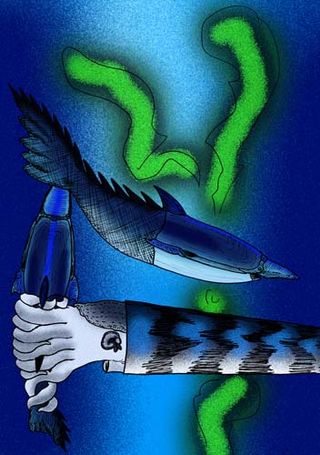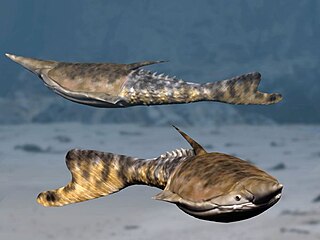
The Silurian is a geologic period and system spanning 24.6 million years from the end of the Ordovician Period, at 443.8 million years ago (Mya), to the beginning of the Devonian Period, 419.2 Mya. The Silurian is the shortest period of the Paleozoic Era. As with other geologic periods, the rock beds that define the period's start and end are well identified, but the exact dates are uncertain by a few million years. The base of the Silurian is set at a series of major Ordovician–Silurian extinction events when up to 60% of marine genera were wiped out.

Heterostraci is an extinct subclass of pteraspidomorph jawless vertebrate that lived primarily in marine and estuary environments. Heterostraci existed from the mid-Ordovician to the conclusion of the Devonian.

Psammosteidae is an extinct family of flattened, benthic heterostracan vertebrates that lived in marine and estuary environments in Europe, Russia & North America. They arose during the Early Devonian, with the first known genus, Drepanaspis from the Hunsrück lagerstätte. The Psammosteids were the only heterostracans that survived the Upper Frasnian extinction event during the Late Devonian, dying out in the extinction event at the very end of the Devonian.

Protaspididae is an extinct family of pteraspidid heterostracan agnathans. Fossils of the various genera are found in early Devonian-aged marine strata. Protaspidids were once thought to represent a transitional form between the Pteraspididae and the Psammosteida, bearing the broad head shield shape of the latter, due to a more benthic (bottom-dwelling) existence, but recent phylogenical comparisons demonstrate that the protaspidids are actually highly derived pteraspidids, and that the anchipteraspidids, the most primitive of pteraspidids, are the sister-group of the Psammosteids.
The Grey Downtonian facies occurs in the Downton Castle Sandstone Group of the British Old Red Sandstone, and more or less straddles the Devonian-Silurian boundary. The Ludlow Bone Bed and Temeside Shales are sometimes also included in the Grey Downtonian, which is also referred to as the Temeside group, part of the Downton Series. It is intermediate between the marine flagstones beneath it and the terrestrial deposits above it. The beds were deposited in a marine environment, with some material being washed in from the nearby land.
Poraspis is an extinct genus of heterostracan. Fossils are found in Late Silurian and Early Devonian marine strata of Norway, Canada and the United States.
Ariaspis is an extinct genus of cyathaspidiform heterostracan agnathan. Fossils are found in marine strata of Canada and Europe from the late Silurian period until its extinction during the Early Devonian. A new species, A. arctata, was described by David K. Elliott and Sandra Swift in 2010.
The Wood Bay Series is a geologic formation found on the island of Spitsbergen, Svalbard in Norway. It preserves fossils dating back to the Pragian–Emsian stages of the Devonian period.
The Frænkelryggen Formation is a geologic formation in Svalbard, Norway. The fluvial sandstones and green shales preserve flora and early fish fossils dating back to the Lochkovian stage of the Early Devonian period.

Panamintaspis snowi is an extinct species of pteraspidid heterostracan agnathan which existed during the early Middle Devonian period of Death Valley, California. Fossils are found in Late Emsian-aged marine strata of the Lost Burro Formation. P. snowi strongly resembles Pteraspis, though while it was originally described as a member of the same family, Pteraspididae, a recent phylogenetic reassessment of the order Pteraspidiformes places P. snowi within the paraphyletic family "Protopeteraspidae," as the sister taxon of the suborder Pteraspidoidei.

Pteraspidiformes is an extinct order of heterostracan agnathan vertebrates known from extensive fossil remains primarily from Early Devonian strata of Europe and North America, and from Upper Silurian Canada.

Cyathaspidiformes is an extinct order of heterostracan vertebrates known from extensive fossil remains primarily from Silurian to Early Devonian strata of Europe, and North America, and from Early Devonian marine strata of Siberia.

Blieckaspis priscillae is a pteraspidid heterostracan agnathan from the Middle Devonian of North America.

Cyathaspidida is a taxon of extinct cyathaspidiform heterostracan agnathans whose fossils are found in Silurian to Lower Devonian marine strata of Europe and North America. In life, they are thought to be benthic animals that lived most of their lives either mostly buried in or resting directly on top of the substrate.

Liliaspis philippovae is an extinct cyathaspidiform heterostracan agnathan from early Devonian marine strata of the Ural Mountains.

Traquairaspidiformes is an order of extinct heterostracan agnathan fish known from the Silurian and Early Devonian periods. Fossils are predominantly known from Late Silurian fluvial deposits from Wales and England: some species were also found in strata representing shallow water marine environment in Canada and North America.

Protopteraspididae is an extinct family of pteraspidid heterostracan agnathans. Fossils of the various genera are found in early Devonian-aged marine strata. Protopteraspidids were once thought to represent a taxon of basal pteraspidids but recent evaluations demonstrate that Protopteraspididae is a paraphyletic group of various transitional forms representing a gradual transition between the more advanced Pteraspoidei, and the anchipteraspidids and the Psammosteids.

Lamiaspis longiripa is an extinct pteraspid heterostracan agnathan vertebrate found in marine strata of Early Devonian Nevada.

Pteraspididae is an extinct family of heterostracan vertebrates. It is an Early Devonian-aged family that contains the stereotypical, torpedo-shaped pteraspidids, such as the type genus, Pteraspis, and its close relatives Errivaspis and Rhinopteraspis, that are popularly thought to have actively swam about in the water column. The elongated rostral plate is thought to help with their hydrodynamic ability. Various genera are found in various marine and estuarine strata of Early Devonian Europe and North America.
Anchipteraspididae is an extinct family of heterostracan vertebrates restricted to Late Silurian and Early Devonian strata of Arctic Canada.












